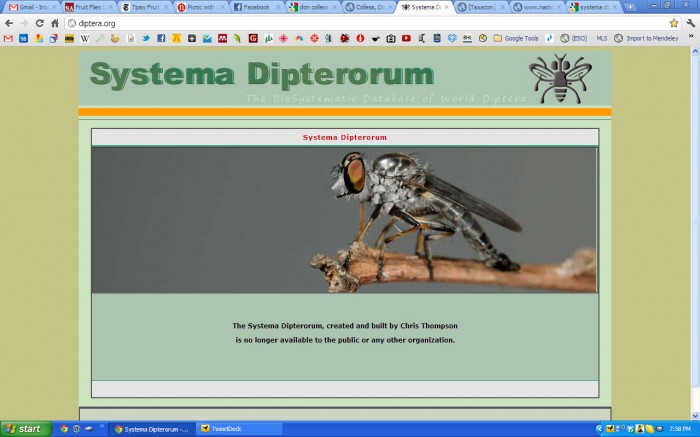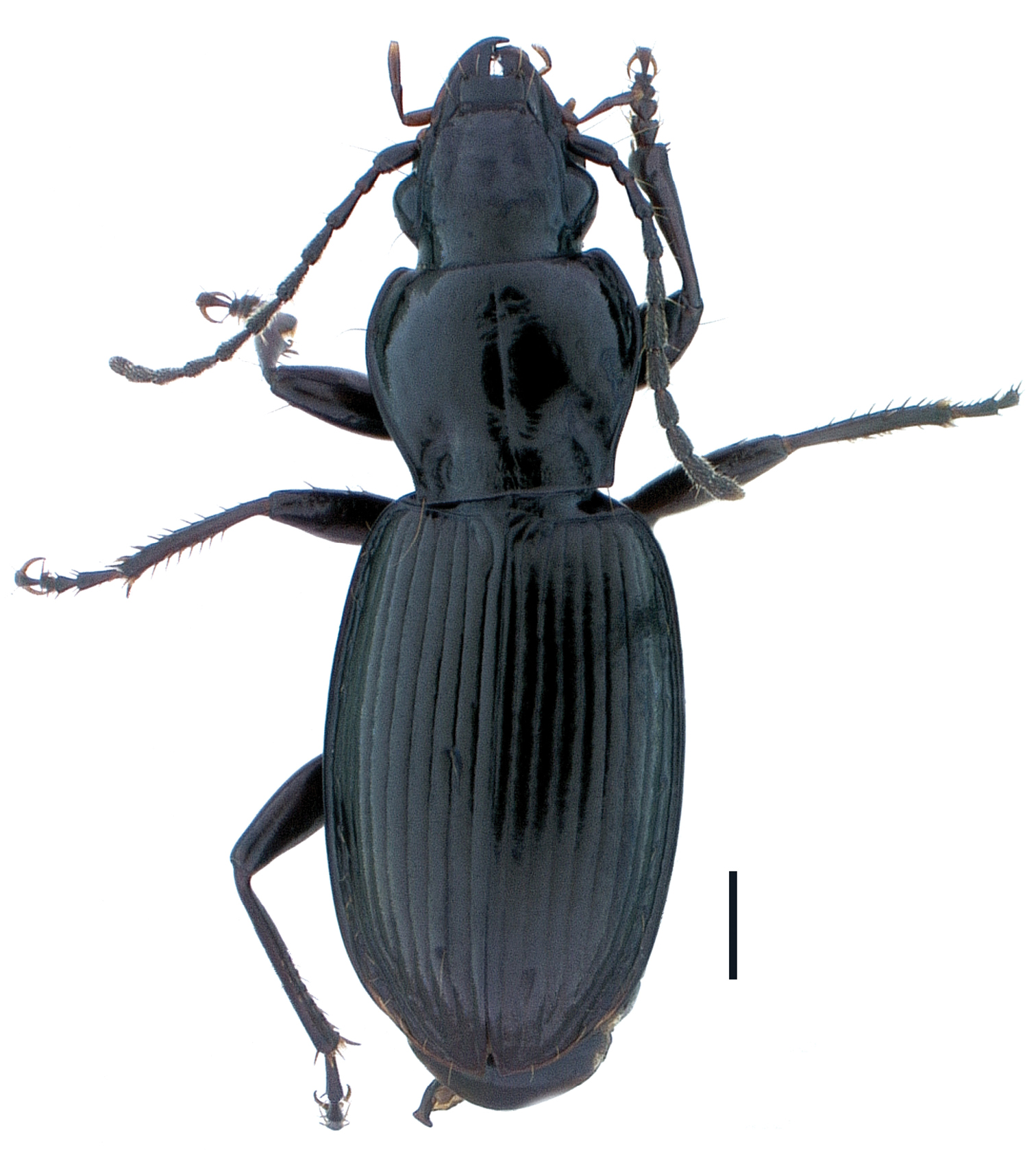Over the past 250 years, hundreds of thousands of flies have been described and given names by taxonomists from around the world. Many of these names have stood the test of time and are still in use today (the common house fly Musca domestica was named by Carl Linneaus in 1758, for example), but many names did not make the cut; sometimes because the species they were assigned to already had names from earlier scientists, sometimes because the name was being used for another animal, and sometimes because we gained a better understanding for how species are related and moved them to a new branch on the tree of life. These synonymous names remain important to us though, and can’t just be discarded or forgotten about, as sometimes they get a second chance at fame following the discovery of new specimens or new characters! Managing all of these names, searching for obscure papers published at any point in the last 250 years and knowing every little detail about a species’ scientific heritage is what keeps taxonomists busy from day to day. Taxonomists are modern day treasure hunters, following maps laid out by our taxonomic forefathers and searching for hidden gems in new & undescribed species.
Traditionally, species names have been tracked in small batches during the course of taxonomic revisions, being updated once a generation or two if we’re lucky. For decades, taxonomy has been underfunded, understaffed and unappreciated, meaning even these small revisions are being done less and less frequently, and by fewer people each generation. This has lead to a situation that has been termed the Taxonomic Impediment. Put simply, there are too many unknown species and not enough time, money or scientists to describe them, with many species disappearing before we even realized they were there.
In the internet age, taxonomists can communicate, collaborate, and compile their expertise into larger ideas and bigger projects. By working together, taxonomists today have begun consolidating tools in open access resources available to the community at large, and more importantly, the public. One such resource is Systema Dipterorum, a clearing house for fly names and taxonomic information. This library of fly taxonomy has been an ongoing project for the past 20 years, originally spearheaded by Dr. F. Christian Thompson, a veteran fly taxonomist and one of the world’s foremost experts on flower flies (Syrphidae). With the help of dipterists from around the world, and the support of Dr. Thomas Pape and the Natural History Museum of Denmark where the online database has been stored for the past few years, this database of fly names has grown to include more than 160,000 species, for which 250,000 different names have been found, recorded and made available in the database (as reported in FlyTimes Issue 46, 2011), along with authors and citations for when those names were first published.
Systema Dipterorum is a shining example of what a taxonomic community can accomplish, even with the limited financial resources provided to it. Other groups have similar resources (see AntWeb.org for the photographic equivalent for Formicidae) but I regard the Diptera community’s combined efforts as one of the greatest accumulations of taxonomic information anywhere. I use this database weekly during the course of my own taxonomic revisions, but I also consult it for my personal endeavors in order to use the most accurate names in my photography and scientific communication, as well as to satisfy my curiosity.
I also use the database to explore the works of other dipterists, to learn what they are passionate about, and to better understand the work being undertaken around the world. To that regard, I visited diptera.org on February 16 to learn more about the work of Australian dipterist Don Colless, who recently passed away. Instead of a world-leading database, I found this:
What made this unsettling discovery even more surprising was Dr. Thompson’s recent commitment to developing the database despite a recent funding cut! Along with Dr. Thompson’s efforts to develop Systema Dipterorum, many from the community have also contributed to the database. Closure of the database is a slap in the face to all who have taken the time to contribute, and a major setback for dipterists everywhere.
Dr. Thompson has said his decision to close Systema Dipterorum was made by the funding cut, but also because he believes he is being forced out of his emeritus position at the Smithsonian Institute in Washington (where he’s been employed for decades). Regardless, Systema Dipterorum should not be used as a negotiating tool, and restricting access holds the entire Diptera community hostage. Hopefully Dr. Thompson and his colleagues will consider officially making the database the property of the global Dipterology community and not remove it, or threaten to remove it again.
As of February 21, Systema Dipterorum has been placed back online, although there appear to be coding issues, with error messages appearing in place of search results, resulting in the system remaining inoperable. Hopefully these kinks will be worked out quickly, restoring Systema Dipterorum to a fully functional state. I can only imagine that administrative abilities and over-arching control strategies will be reexamined after this incident, and safeguards will likely be enacted to prevent a similar situation from occurring again.
The long term future of Systema Dipterorum is anything but assured however. The continual development of this resource will rely on stable funding being available for not only its basic day to day maintenance, but more importantly the continued job of growing the database through the addition of names and taxonomic information. Perhaps it’s time for the international Diptera community to move from an informal association of like-minded individuals (like those found in the North American Dipterists Society or the Diptera.info community) towards a more formal society, complete with an elected governing board, constitution and devoted, voting membership. We’re not far from such a society; the North American Dipterists Society meets biannually, while an International Congress of Dipterology is held every four years, and dipterists have taken to Facebook and other social media to facilitate communication between formal gatherings. I’m sure that establishing an international society can be a delicate endeavor, but what better time than the present to begin the process, promote international collaboration and encourage prospective dipterists from around the world to become involved in a global initiative? An International Society of Dipterists could then be made stewards of Systema Dipterorum, helping to ensure its continued development by research groups and enthusiastic specialists as a leading mandate for the society.
There have been major strides made by the Diptera community to advance not only our knowledge of fly diversity and taxonomy, but also to advance the profile of taxonomists in general. In an age where taxonomists are becoming endangered species, it’s imperative that we band together and remind funding agencies, universities and governments about the vital role the science of taxonomy plays in all aspects of biology, and encourage these institutions to return to investing in the training, employment and funding of taxonomists, before the Taxonomic Impediment becomes the Taxonomic Impoverishment.
UPDATE March 5, 2012: It seems Systema Dipterorum is fully functional again. Go find taxonomic info while you can people!


